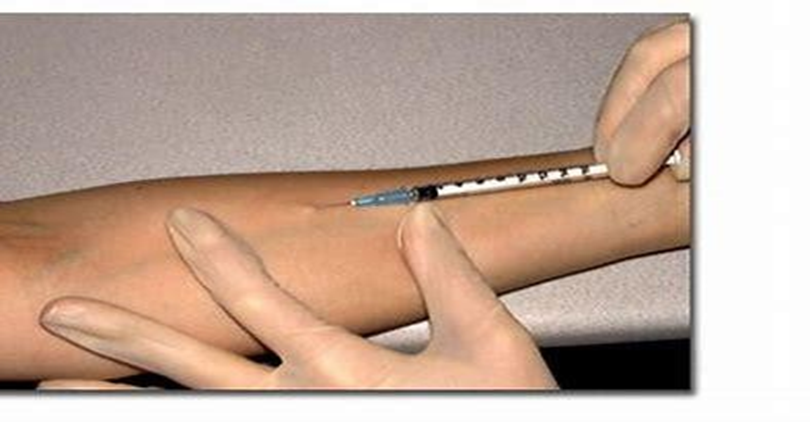A nurse is planning to administer a tuberculin skin test to a client who has had an exposure to tuberculosis. Which of the following actions should the nurse plan to take?
Select an injection site that is free of scar tissue.
Massage the site following the injection.
Hold the needle at a 30 angle during injection
Inject 0.3 to 0.5 mL of the solution.
The Correct Answer is A
A. When administering a TST, the nurse should select an injection site that is free of scar tissue and areas with excessive hair, veins, or visible lesions. The preferred site for TST administration is the volar aspect of the forearm, approximately 2-4 inches below the elbow.
B. After administering the TST, the nurse should not massage or manipulate the injection site. Massaging the site can cause irritation or spread the solution, leading to inaccurate results.
C. he TST is administered intradermally, typically with a 27-gauge needle. The needle should be inserted with the bevel facing upward at a 5-15-degree angle.
D. The standard dose of tuberculin solution (e.g., purified protein derivative, PPD) for a TST is 0.1 mL containing 5 tuberculin units (TU).

Nursing Test Bank
Naxlex Comprehensive Predictor Exams
Related Questions
Correct Answer is D
Explanation
D. Drawing the NPH last ensures that it does not contaminate the short acting insulin. The regular insulin should be drawn first.
A. Regular and NPH insulin should not be mixed together in a single syringe prior to administration. Mixing them could alter their action profiles and affect their effectiveness.
B. While injecting air into the vial before withdrawing medication helps prevent negative pressure and facilitates easy withdrawal of the medication, it should be done for each vial individually, not specifically for the regular insulin vial.
C. The medication should be drawn up into the same syringe before administration to the patient.
Correct Answer is A
Explanation
A. According to the recommended immunization schedule, the second dose of the MMR vaccine is typically administered at 4 to 6 years of age, before starting school. This booster dose helps ensure long- term immunity against measles, mumps, and rubella.
B. The MMR vaccine is typically administered in two doses: the first dose at 12 to 15 months of age and the second dose at 4 to 6 years of age. There is no need for additional MMR immunizations over the next 2 years if the child receives the recommended doses.
C. While the child may receive additional immunizations at 3 years of age, such as the hepatitis B vaccine, the second dose of the MMR vaccine is typically administered at 4 to 6 years of age, not 3 years.
D. Titer testing is typically not recommended for determining the need for further MMR immunizations in young children. The immunization schedule provides specific recommendations for MMR vaccine doses based on age, rather than individual titers.
Whether you are a student looking to ace your exams or a practicing nurse seeking to enhance your expertise , our nursing education contents will empower you with the confidence and competence to make a difference in the lives of patients and become a respected leader in the healthcare field.
Visit Naxlex, invest in your future and unlock endless possibilities with our unparalleled nursing education contents today
Report Wrong Answer on the Current Question
Do you disagree with the answer? If yes, what is your expected answer? Explain.
Kindly be descriptive with the issue you are facing.
